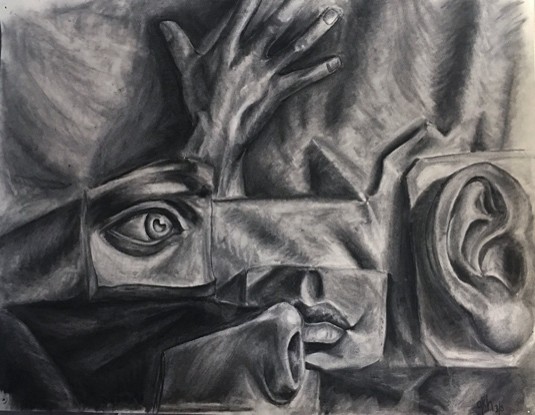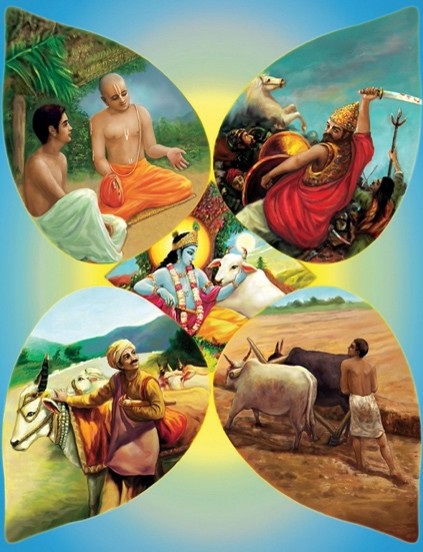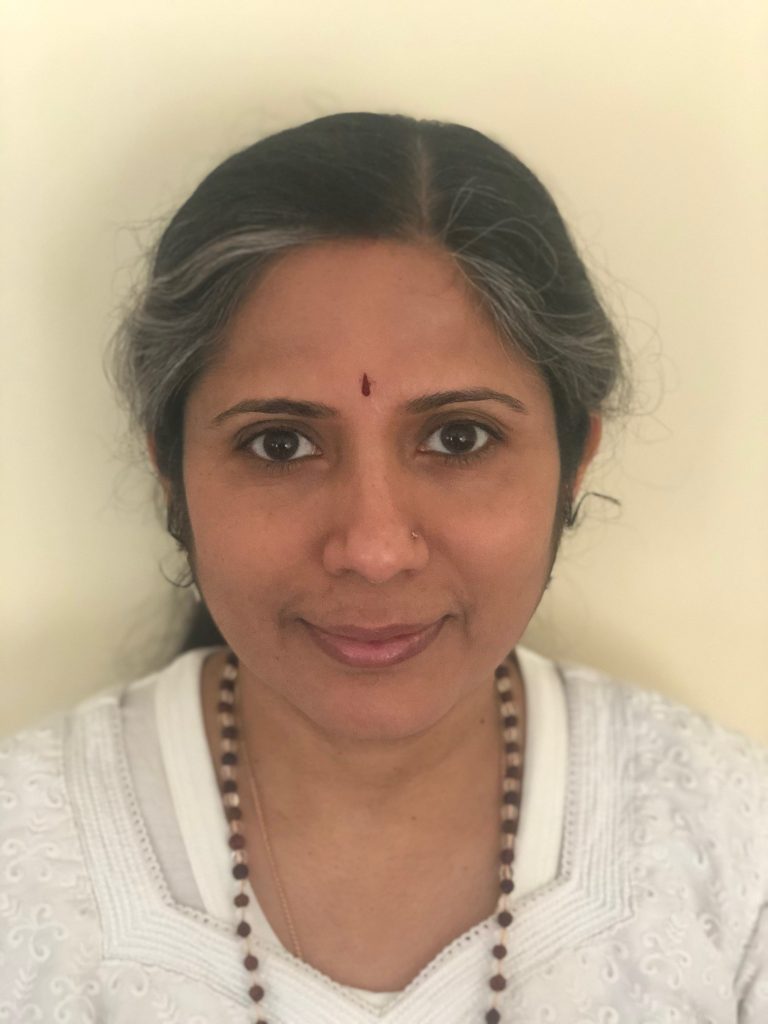Bhagavad Gita Chapters 3, 4 & 5
By Nirooshitha Sethuram, Yogaratna
Graphics by Sheralee (Shambhavi) Hancherow
Chapter 3: Karma Yoga — The Yoga of Action
This chapter of the Bhagavad Gita is both profound and practical. It teaches the importance of performing one’s duty without attachment to the results.

Krishna explains to Arjuna that action is essential and that it should not be avoided. In Karma Yoga, the emphasis is on selfless actions, which are performed as an offering to the Divine. This helps in purifying your mind and leading you towards liberation from the cycle of birth & death.
Krishna advises Arjuna to act according to his dharma, his duty as a warrior — to fight for justice without any desire for personal gain. Krishna further clarifies that performing one’s duty with the right attitude, without selfish desires, and with a sense of devotion, transforms mundane actions into acts of worship.
Describing kama (desire) and krodha (anger), he points out the way to conquer them. He encourages the cultivation of equanimity, where success and failure are met with the same serene disposition.
By practicing Karma Yoga, you can rise above your ego and achieve a state of inner peace and fulfillment, realizing your true purpose in life. This chapter is a guide to living a life of righteousness and dedication, ultimately leading to spiritual growth and enlightenment.
The Dialog
Arjuna says, “With words that seem contradictory, you confuse me. If knowledge is superior to action, then why do you involve me in this dreadful war? Therefore, tell me that one thing by which I shall reach the Highest Goal.”

Krishna says, “There are two paths: Jñana Yoga for the followers of the path of knowledge, and Karma Yoga for the followers of the path of action or work. No one can live without doing work. Everyone, without their choice, is compelled to do work by the qualities of their birth.
“Controlling your senses with your mind and commencing the discipline of Karma Yoga, by action without attachment, is the best. Actions, other than sacred actions (Yajña), bind this world. So, perform your work as sacred action, without attachment. Nourish the Gods with sacred action and they will nourish you.
“Beings are born of food, food is produced from rain, rain arises from sacred action, sacred action is born of performing prescribed duties. Duties are prescribed in the Vedas, the Vedas are born from the Imperishable Paramatma (Supreme Self). Therefore, know that the Supreme Being is eternally present in sacred action (yajna).
“The one who performs all their prescribed duties in an unfettered spirit will attain the Supreme. For myself, there is no duty for Me in these worlds. There is nothing unattained or to be attained for me. Yet I am also engaged in work. These worlds would perish if I did not perform work.
“While the worldly-minded work with attachment, deluded by egoism, thinking ‘I am the doer,’ the wise act without attachment for the welfare of the world. Perform all actions for Me, with your mind fixed in Atman (Self), free from hope and egoism, act without mental agitation.”
Arjuna asks, “But, what impels man to commit sin, even against his wishes?”
Krishna replies, “It is desire, it is anger, born of the active impulse of action, all-consuming and creating sin. Know this as the foe here in this world. Knowledge of the Self is enveloped by desire and anger. It is covered by this ceaseless enemy, insatiable like fire.

“The senses, the mind, and the intellect are the seat of desire. Control first these senses, thus, killing this sin-causing desire, which destroys knowledge and Self-Realization.
“They say that the senses are superior to the body; superior to the senses is the mind; superior to the mind is the intellect; one who is even superior to the intellect is the Atman. Having known Atman is greater than the intellect and restraining the mind by the intellect, conquer the foe, in the form of desire, no doubt hard indeed to conquer.”
Chapter 4: Jñana Yoga — The Yoga of Wisdom
Krishna now expounds on the significance of knowledge and wisdom in the pursuit of spiritual enlightenment.
Jñana Yoga emphasizes understanding the true nature of reality, Self-Realization and the importance of acquiring knowledge that leads to liberation.
This chapter is profound and enlightening. It teaches that true liberation comes from understanding the eternal nature of the Self and the universe. By acquiring Divine knowledge, practicing self-discipline and performing selfless actions, you can rise above spiritual ignorance and attain the highest state of spiritual enlightenment.

Krishna emphasizes that all paths of yoga ultimately lead to the same goal — Self-Realization and liberation. Whether one follows the path of knowledge, action, or devotion, the essence remains the same. He explains that a wise person sees unity in the diversity of the world, recognizing the Divine Presence in everything and everyone.
He also shares how a realized being perceives the oneness of all existence. Such a person transcends the dualities of pleasure and pain, success and failure, and remains established in the eternal truth. This state of Realization brings inner peace and fulfillment.
In conclusion, this chapter is a guide to living a life of wisdom, righteousness and devotion. It inspires us to seek knowledge, cultivate inner purity and realize our true purpose in life. Through Jñana Yoga, we can achieve a state of inner peace, fulfillment and ultimate liberation.
The Dialog
Krishna continues, “This undying Yoga of Action was taught to the Sun by me at the beginning of creation. The Sun taught it to his son, the Moon, who taught it to his son Ikshvaku, then it was handed down in succession from generation to generation.
“However, by long lapse of time, this Yoga was lost to the world. This same ancient Yoga has now been taught to you by Me. This is a supreme secret.”
Arjuna asks, “You were born after the Sun. How am I to understand that you taught it to him in the beginning?”
Krishna smiles and says, “Many births of mine have passed by, as well as yours. I know them all but you don’t. I manifest Myself whenever there is a decline of righteousness and rise of evil.
“For the protection of the good, for the destruction of the wicked and for the establishment of dharma, righteousness, I take birth in every age. Those who understand the Divine nature of my birth and my activities, upon leaving their body, do not have to take birth again, but come to my eternal abode.
“Free from attachment, fear and anger, being absorbed in Me, taking refuge in Me, purified by the fire of Knowledge, many have attained My Being. In whatsoever form one seeks Me, I reach him in that form, for all humankind tread in the paths I laid down for them.

“The four castes were created by Me according to the division of gunas and karma. Actions do not taint Me, nor have I any desire for the fruits of action. He who knows Me thus is not bound by his actions.
“The one who sees action in inaction and inaction in action is the wise one. He who has given up attachment to the fruits of action, who is always content, and who depends on nothing, though engaged in action does not do anything.
“Brahman verily shall be reached by the sacrifice (sacred action), by anyone who always sees Brahman in all actions. There are many types of sacred actions in the Vedas. All who know the secret of sacred action, and engage in it, progress toward liberation.
“Learn the Truth by approaching a spiritual Master. Learn from him and serve such a one who has seen the Truth.
“Certainly, there is no purifier in this world like Divine Knowledge. One who attains perfection through yoga finds this knowledge in the Self in time. Actions do not bind one who has renounced actions by yoga, whose doubts are dispelled by knowledge and who abide in the Self.”
Chapter 5: Karma Sannyasa Yoga — The Yoga of Renunciation of Action
Now Krishna addresses Arjuna’s confusion regarding the paths of renunciation and selfless action.
He elaborates on the importance of performing one’s duty without attachment to the results. True renunciation does not mean abandoning action altogether, but rather renouncing the desire for the fruits of actions.
Krishna explains that both the path of knowledge (Jñana Yoga) and the path of selfless action (Karma Yoga) lead to liberation.
Karma Yoga is more suitable for those who find it challenging to renounce all actions and to meditate constantly. By performing their duties selflessly and dedicating their actions to the Divine, they can attain the same state of enlightenment as those who follow the path of knowledge.
He emphasizes that a true sannyasi, the renunciant, is the one who neither hates nor desires, and is free from the dualities of life. Such a person is always content and self-sufficient, finding peace within themselves.

Krishna also introduces the concept of the realized being, who sees all beings with an equal eye, recognizing the same Divine Presence in everyone. He further explains the nature of selfless action, stating that actions performed without attachment, ego and desire do not create bondage.
By understanding the eternal Self, which is beyond birth and death, one can transcend the limitations of the physical body and mind. This knowledge leads to inner peace and freedom from the cycle of birth and death.
This chapter teaches us the significance of performing our duties selflessly, without attachment to the outcomes. It inspires us to cultivate a balanced and equanimous mind, free from desires and aversions. By following the path of Karma Sannyasa Yoga, we can achieve spiritual liberation and experience the eternal bliss of the Divine.
More to come…
- Arjuna listening to Krishna explaining Karma Yoga
https://hindutempletalk.org/2023/08/26/bhagavat-gita-chapter-3-karma-yoga/ ↩︎ - Jñana and Karma Yoga ↩︎
- The Five Senses
https://www.expandthebliss.com/post/how-to-control-your-senses ↩︎ - Unity & Diversity in the World
https://easy-peasy.ai/ai-image-generator/images/aid-for-humanity-global-call-for-help-and-support ↩︎ - The Four Castes
https://learngitalivegita.com/blog/what-is-karma-yoga/ ↩︎ - Krishna explaining to Arjuna the true Sannyasi & Realized Being
https://www.facebook.com/photo.php?fbid=4319444351448829&id=164442610282378&set=a.626267237433244 ↩︎
